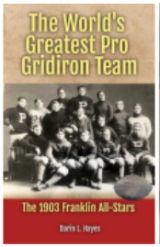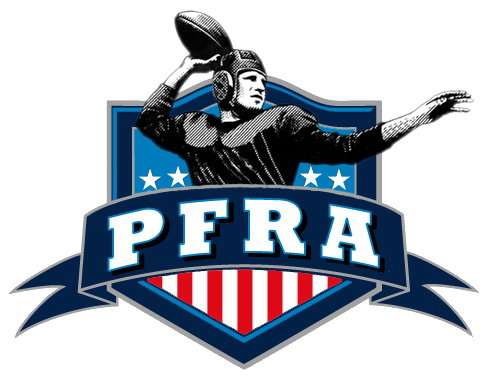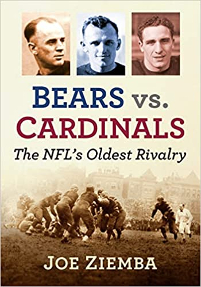Edgerrin James
Born August 1, 1978 - Immokalee, Florida - Edgerrin James, the Pro Football Hall of Fame running back of the Indianapolis Colts and later the Arizona Cardinals and Seattle Seahawks.
Edgerrin attended and played football for the Miami Hurricanes enjoying a stellar collegiate career. It was when he was picked up by the Colts in the 1999 NFL Draft that this young runner really found his groove though according to the ProFootballHOF.com. Edge earned NFL Rookie of the year honors in 1999 when he rushed for 1553 yards leading all runner in the League!
He accomplished winning the NFL rushing title again in 2000 with 1709 yards on the ground matching his TDs scored in 1999 at 13 times crossing the wide field stripe.
In fact during his 11 year career James blasted past the 1000 yard rushing mark an amazing 7 times edging past 1500 in four of those! FOr his career he recorded 12246 yards rushing with 80 scores, played in four Pro Bowls and was honored to be on the All-2000's NFL team. Let's not forget that he also hauled in 433 catches many from HOF QBs Peyton Manning and Kurt Warner for an additional 3364 yards of offense.
Edgerrin attended and played football for the Miami Hurricanes enjoying a stellar collegiate career. It was when he was picked up by the Colts in the 1999 NFL Draft that this young runner really found his groove though according to the ProFootballHOF.com. Edge earned NFL Rookie of the year honors in 1999 when he rushed for 1553 yards leading all runner in the League!
He accomplished winning the NFL rushing title again in 2000 with 1709 yards on the ground matching his TDs scored in 1999 at 13 times crossing the wide field stripe.
In fact during his 11 year career James blasted past the 1000 yard rushing mark an amazing 7 times edging past 1500 in four of those! FOr his career he recorded 12246 yards rushing with 80 scores, played in four Pro Bowls and was honored to be on the All-2000's NFL team. Let's not forget that he also hauled in 433 catches many from HOF QBs Peyton Manning and Kurt Warner for an additional 3364 yards of offense.
O.J. Simpson
Born July 9, 1947 - San Francisco, California - O. J. Simpson the legendary Southern California running Back of the seasons of 1967 and 1968. O.J. Simpson Pro Football Hall of Fame Running Back that played for the Buffalo Bills.
Simpson held the NFL single season rushing record of 2003 yards until Eric Dickerson broke that record a few decades later. Known as "the Juice" he played college ball at USC. According to the National Football Foundation, in 1968, O.J. carried the ball 355 times for 1709 yards and 22 touchdowns while leading USC to a 9-0-1 regular season record, equalling or bettering a long list of USC records. Again, he was named to scores of All-America first teams and was granted 21 awards, including Rose Bowl MVP, the Heisman Trophy and Maxwell Award.After winning the Heisman Trophy in 1968 the College Football Hall of Fame inducted them into their museum in 1983's class.
Juice went into broadcasting and even acting after his NFL career was over.
Simpson held the NFL single season rushing record of 2003 yards until Eric Dickerson broke that record a few decades later. Known as "the Juice" he played college ball at USC. According to the National Football Foundation, in 1968, O.J. carried the ball 355 times for 1709 yards and 22 touchdowns while leading USC to a 9-0-1 regular season record, equalling or bettering a long list of USC records. Again, he was named to scores of All-America first teams and was granted 21 awards, including Rose Bowl MVP, the Heisman Trophy and Maxwell Award.After winning the Heisman Trophy in 1968 the College Football Hall of Fame inducted them into their museum in 1983's class.
Juice went into broadcasting and even acting after his NFL career was over.
Retired Jersey Numbers of the Pittsburgh Steelers
The Pittsburgh Steelers, a franchise synonymous with excellence and tradition, have a storied history marked by legendary players and iconic moments. At the heart of this legacy are the retired jersey numbers that honor some of the greatest athletes to ever step onto the gridiron. Each retired number symbolizes more than just a player; it represents the enduring impact, leadership, and prowess that have defined the Steelers' remarkable success over the years.
In this series of posts, we will delve into the stories behind each retired jersey number of the Pittsburgh Steelers, celebrating the extraordinary individuals who wore them. From the fearsome defenders who redefined the art of tackling to the dynamic playmakers who dazzled fans with their skill, these numbers commemorate the contributions of players whose excellence elevated the franchise to new heights.
We will explore the significant achievements and memorable moments associated with each retired number, offering insights into how these legends shaped not only the Steelers' legacy but also the broader landscape of the NFL. Through detailed profiles and historical context, this series will provide a comprehensive look at the careers of these iconic figures, highlighting their impact both on and off the field.
Join us as we pay tribute to the heroes of the Pittsburgh Steelers' past, celebrating the individuals who have left an indelible mark on the team and the sport of football. Each post will bring to life the storied careers and enduring contributions of the players whose jersey numbers have been immortalized in Steelers history.
Here are the honored players and their numbers that are not issued in Miami anymore:
-Jersey Number 32
Franco Harris 1972–1983
-Jersey Number 70
Ernie Stautner 1950–1963
-Jersey Number 75
Joe Greene 1969–1981
If you love football jersey designs and evolution, wait until you check out the History of American Football Jersey.
-Football Jersey Frequently Asked Questions
-What are American football jerseys made of? Modern jerseys are made of synthetic fibers such as polyester or a blend of different materials such as spandex. For more, check out our in-depth study of The Makeup and Materials of Football Jerseys.
-What NFL franchise(s) has/have the most retired jersey numbers? The Chicago Bears and the New York Giants each lead the league with 14 different numbers retired. They have to duplicate when 90-man rosters are in effect.
-When did football jerseys start having numbers on them? Though there was documented talk of it since 1894, players only wore digits in a 1905 Iowa State at Drake game. Check out more on this story The Origins Of Football Player Numbers.
-Whose college football jersey was the first to be retired? Red Grange's Number 77 Ilinois Illini jersey was the first college uni shelved in 1925. There were a couple more about the same time, and we chatted with a college football expert historian to help divulge College Football and its First Retired Jerseys.
In this series of posts, we will delve into the stories behind each retired jersey number of the Pittsburgh Steelers, celebrating the extraordinary individuals who wore them. From the fearsome defenders who redefined the art of tackling to the dynamic playmakers who dazzled fans with their skill, these numbers commemorate the contributions of players whose excellence elevated the franchise to new heights.
We will explore the significant achievements and memorable moments associated with each retired number, offering insights into how these legends shaped not only the Steelers' legacy but also the broader landscape of the NFL. Through detailed profiles and historical context, this series will provide a comprehensive look at the careers of these iconic figures, highlighting their impact both on and off the field.
Join us as we pay tribute to the heroes of the Pittsburgh Steelers' past, celebrating the individuals who have left an indelible mark on the team and the sport of football. Each post will bring to life the storied careers and enduring contributions of the players whose jersey numbers have been immortalized in Steelers history.
Here are the honored players and their numbers that are not issued in Miami anymore:
-Jersey Number 32
Franco Harris 1972–1983
-Jersey Number 70
Ernie Stautner 1950–1963
-Jersey Number 75
Joe Greene 1969–1981
If you love football jersey designs and evolution, wait until you check out the History of American Football Jersey.
-Football Jersey Frequently Asked Questions
-What are American football jerseys made of? Modern jerseys are made of synthetic fibers such as polyester or a blend of different materials such as spandex. For more, check out our in-depth study of The Makeup and Materials of Football Jerseys.
-What NFL franchise(s) has/have the most retired jersey numbers? The Chicago Bears and the New York Giants each lead the league with 14 different numbers retired. They have to duplicate when 90-man rosters are in effect.
-When did football jerseys start having numbers on them? Though there was documented talk of it since 1894, players only wore digits in a 1905 Iowa State at Drake game. Check out more on this story The Origins Of Football Player Numbers.
-Whose college football jersey was the first to be retired? Red Grange's Number 77 Ilinois Illini jersey was the first college uni shelved in 1925. There were a couple more about the same time, and we chatted with a college football expert historian to help divulge College Football and its First Retired Jerseys.
Franco Harris A Steelers Legend Steeped in Super Bowl Glory
Born March 7, 1950, in Fort Dix, New Jersey, was the 6'-2" 230 pounds full back from the early 1970's Penn State Nittany Lions, Franco Harris.
Franco Harris was more than just a running back; he was a cornerstone of the Pittsburgh Steelers' dynasty in the 1970s and a beloved figure in the world of football. His career, spanning 13 seasons from 1972 to 1984, was marked by exceptional talent, clutch performances, and a place in Super Bowl history.
A Rising Star and the "Immaculate Reception":
Drafted by the Steelers in 1972, Harris quickly established himself as a key contributor. His rookie season was forever etched in history with the iconic "Immaculate Reception," a controversial play in the AFC Divisional playoffs against the Oakland Raiders. Harris' reception, initially ruled a touchdown, solidified his place in Steelers lore and propelled them to the Super Bowl.
Super Bowl Dominance and Consistent Production:
Harris played a crucial role in all four of the Steelers' Super Bowl victories in the 1970s, earning Super Bowl IX MVP honors for his dominant performance in 1975. He rushed for 101 carries and 354 yards in his Super Bowl appearances, ranking among the all-time leaders in these categories.
Beyond his Super Bowl success, Harris consistently delivered impressive results throughout his career. He rushed for over 1,000 yards in eight seasons and finished his career with 12,120 rushing yards, ranking him among the top-10 rushers in NFL history at the time of his retirement.
An Unorthodox Style and Enduring Legacy:[b]
Harris's running style, characterized by a high leg kick and avoiding unnecessary contact, initially drew skepticism. However, his effectiveness and longevity silenced his critics. He was known for his quick thinking, his ability to make defenders miss tackles, and his exceptional work ethic.
-[b]Career information
High school: Rancocas Valley Regional
(Mount Holly, New Jersey)
College: Penn State (1968–1971)
NFL draft: 1972 / round: 1 / pick: 13
-Career history
Pittsburgh Steelers (1972–1983)
Seattle Seahawks (1984)
-Career highlights and awards
-4× Super Bowl champion (IX, X, XIII, XIV)
-Super Bowl MVP (IX)
-NFL Offensive Rookie of the Year (1972)
-NFL Man of the Year (1976)
-First-team All-Pro (1977)
-2× Second-team All-Pro (1972, 1975)
-9× Pro Bowl (1972–1980)
-NFL rushing touchdowns leader (1976)
-NFL 1970s All-Decade Team
-Pittsburgh Steelers All-Time Team
-Pittsburgh Steelers Hall of Honor
-Pittsburgh Steelers No. 32 retired
-Pittsburgh Pro Football Hall of Fame
-2× Second-team All-East (1969, 1971)
-Career NFL statistics
Rushing yards: 12,120
Yards per carry: 4.1
Rushing touchdowns: 91
Receptions: 307
Receiving yards: 2,287
Receiving touchdowns: 9
Stats at Pro-Football-Reference.com
Franco Harris was more than just a running back; he was a cornerstone of the Pittsburgh Steelers' dynasty in the 1970s and a beloved figure in the world of football. His career, spanning 13 seasons from 1972 to 1984, was marked by exceptional talent, clutch performances, and a place in Super Bowl history.
A Rising Star and the "Immaculate Reception":
Drafted by the Steelers in 1972, Harris quickly established himself as a key contributor. His rookie season was forever etched in history with the iconic "Immaculate Reception," a controversial play in the AFC Divisional playoffs against the Oakland Raiders. Harris' reception, initially ruled a touchdown, solidified his place in Steelers lore and propelled them to the Super Bowl.
Super Bowl Dominance and Consistent Production:
Harris played a crucial role in all four of the Steelers' Super Bowl victories in the 1970s, earning Super Bowl IX MVP honors for his dominant performance in 1975. He rushed for 101 carries and 354 yards in his Super Bowl appearances, ranking among the all-time leaders in these categories.
Beyond his Super Bowl success, Harris consistently delivered impressive results throughout his career. He rushed for over 1,000 yards in eight seasons and finished his career with 12,120 rushing yards, ranking him among the top-10 rushers in NFL history at the time of his retirement.
An Unorthodox Style and Enduring Legacy:[b]
Harris's running style, characterized by a high leg kick and avoiding unnecessary contact, initially drew skepticism. However, his effectiveness and longevity silenced his critics. He was known for his quick thinking, his ability to make defenders miss tackles, and his exceptional work ethic.
-[b]Career information
High school: Rancocas Valley Regional
(Mount Holly, New Jersey)
College: Penn State (1968–1971)
NFL draft: 1972 / round: 1 / pick: 13
-Career history
Pittsburgh Steelers (1972–1983)
Seattle Seahawks (1984)
-Career highlights and awards
-4× Super Bowl champion (IX, X, XIII, XIV)
-Super Bowl MVP (IX)
-NFL Offensive Rookie of the Year (1972)
-NFL Man of the Year (1976)
-First-team All-Pro (1977)
-2× Second-team All-Pro (1972, 1975)
-9× Pro Bowl (1972–1980)
-NFL rushing touchdowns leader (1976)
-NFL 1970s All-Decade Team
-Pittsburgh Steelers All-Time Team
-Pittsburgh Steelers Hall of Honor
-Pittsburgh Steelers No. 32 retired
-Pittsburgh Pro Football Hall of Fame
-2× Second-team All-East (1969, 1971)
-Career NFL statistics
Rushing yards: 12,120
Yards per carry: 4.1
Rushing touchdowns: 91
Receptions: 307
Receiving yards: 2,287
Receiving touchdowns: 9
Stats at Pro-Football-Reference.com
Famous NFL Players That Wore the Jersey Number 32
The NFL jersey is more than just a piece of fabric; it's a symbol of legacy. Each number carries a unique history, etched with the triumphs and struggles of countless athletes. This series delves into the illustrious past of one such number: 32.
Cardinals at Redskins 12/17/17 by Keith Allison from Hanover, MD via Wikimedia Commons
From Hall of Fame quarterbacks to dominant defensive stars, the jersey bearing the number 32 has been worn by some of the most iconic figures in NFL history. We'll journey through time, exploring the careers of these legendary players, analyzing their impact on the game, and uncovering the stories that have made them unforgettable.
This series will not only celebrate the on-field achievements of these No. 32 greats but also delve into their personal narratives, highlighting their dedication, perseverance, and the unique qualities that set them apart. Join us as we honor the legacy of these exceptional athletes and uncover the fascinating history behind one of the most intriguing numbers in NFL history.
Cardinals at Redskins 12/17/17 by Keith Allison from Hanover, MD via Wikimedia Commons
From Hall of Fame quarterbacks to dominant defensive stars, the jersey bearing the number 32 has been worn by some of the most iconic figures in NFL history. We'll journey through time, exploring the careers of these legendary players, analyzing their impact on the game, and uncovering the stories that have made them unforgettable.
This series will not only celebrate the on-field achievements of these No. 32 greats but also delve into their personal narratives, highlighting their dedication, perseverance, and the unique qualities that set them apart. Join us as we honor the legacy of these exceptional athletes and uncover the fascinating history behind one of the most intriguing numbers in NFL history.
Franco Harris
The exceptional running back from Penn State drove the ground game and offensive success of the 1970s Pittsburgh Steelers.
Franco Harris wasn't just a running back; he was a symbol of Steelers dynasty, blue-collar spirit, and one of the most celebrated figures in NFL history. From his iconic run in Super Bowl IX to his longevity and consistency, Harris left an indelible mark on the gridiron that continues to inspire.
Drafted by the Pittsburgh Steelers in 1972, Harris immediately made an impact. His powerful running style and knack for finding the end zone made him a perfect fit for the "Steel Curtain" era. He formed a dynamic duo with quarterback Terry Bradshaw, terrorizing defenses and leading the Steelers to four Super Bowl victories in six years.
But Harris wasn't just about touchdowns. He was a complete back, excelling in both rushing and receiving. His durability was legendary, racking up over 12,000 rushing yards and 91 touchdowns in his 13-year career, despite playing in a physically demanding era.
His most iconic moment came in Super Bowl IX, when his 64-yard touchdown run in the dying moments of the game sealed victory for the Steelers against the Minnesota Vikings. This "Immaculate Reception," forever etched in NFL lore, solidified Harris's place as a Steelers legend and one of the sport's most unforgettable moments.
Harris's impact transcended the field. He was a leader in the locker room and a beloved figure in Pittsburgh. His blue-collar work ethic and infectious smile resonated with fans, making him a symbol of the city's resilience and character.
Franco Harris wasn't just a running back; he was a symbol of Steelers dynasty, blue-collar spirit, and one of the most celebrated figures in NFL history. From his iconic run in Super Bowl IX to his longevity and consistency, Harris left an indelible mark on the gridiron that continues to inspire.
Drafted by the Pittsburgh Steelers in 1972, Harris immediately made an impact. His powerful running style and knack for finding the end zone made him a perfect fit for the "Steel Curtain" era. He formed a dynamic duo with quarterback Terry Bradshaw, terrorizing defenses and leading the Steelers to four Super Bowl victories in six years.
But Harris wasn't just about touchdowns. He was a complete back, excelling in both rushing and receiving. His durability was legendary, racking up over 12,000 rushing yards and 91 touchdowns in his 13-year career, despite playing in a physically demanding era.
His most iconic moment came in Super Bowl IX, when his 64-yard touchdown run in the dying moments of the game sealed victory for the Steelers against the Minnesota Vikings. This "Immaculate Reception," forever etched in NFL lore, solidified Harris's place as a Steelers legend and one of the sport's most unforgettable moments.
Harris's impact transcended the field. He was a leader in the locker room and a beloved figure in Pittsburgh. His blue-collar work ethic and infectious smile resonated with fans, making him a symbol of the city's resilience and character.
From Hoya Hercules to NFL All-Star, a Life Cut Short
Albert Charles Blozis, known better as "Al," wasn't your average football player. He was a titan of a man, a gentle giant who dominated the gridiron and embodied the spirit of collegiate and professional athletics. His story is one of phenomenal strength, unwavering character, and a tragic twist of fate that left an indelible mark on the world of sports.
Born in Garfield, New Jersey, in 1919, Blozis's athletic prowess blossomed early. He excelled in football and track and field, standing at a towering 6-6 and weighing 245 pounds. At Georgetown University, he became a legend, earning the nickname "Hoya Hercules" for his dominance on the offensive line. He won three consecutive AAU and NCAA shot put titles, setting a world indoor record, and anchored the football team to two undefeated seasons.
In 1942, the NFL beckoned. The New York Giants drafted Blozis, and he quickly made his mark, earning All-Pro honors as a rookie. He was a force to be reckoned with, known for his devastating tackles and ability to clear paths for the Giants' running backs. His athleticism even earned him the nickname "the Human Bulldozer."
But World War II interrupted his burgeoning career. Blozis enlisted in the Army and served with distinction, setting the Army's hand-grenade throwing record with a toss of 94 yards. In 1945, tragedy struck. Just two weeks after arriving in France, Blozis was killed in action, leading a patrol to rescue wounded soldiers.
His death at the age of 26 sent shockwaves through the sports world. The New York Giants named their athletic center in Frankfurt, Germany, after him, and in 1986, he was inducted into the National Football Foundation's College Football Hall of Fame.
Born in Garfield, New Jersey, in 1919, Blozis's athletic prowess blossomed early. He excelled in football and track and field, standing at a towering 6-6 and weighing 245 pounds. At Georgetown University, he became a legend, earning the nickname "Hoya Hercules" for his dominance on the offensive line. He won three consecutive AAU and NCAA shot put titles, setting a world indoor record, and anchored the football team to two undefeated seasons.
In 1942, the NFL beckoned. The New York Giants drafted Blozis, and he quickly made his mark, earning All-Pro honors as a rookie. He was a force to be reckoned with, known for his devastating tackles and ability to clear paths for the Giants' running backs. His athleticism even earned him the nickname "the Human Bulldozer."
But World War II interrupted his burgeoning career. Blozis enlisted in the Army and served with distinction, setting the Army's hand-grenade throwing record with a toss of 94 yards. In 1945, tragedy struck. Just two weeks after arriving in France, Blozis was killed in action, leading a patrol to rescue wounded soldiers.
His death at the age of 26 sent shockwaves through the sports world. The New York Giants named their athletic center in Frankfurt, Germany, after him, and in 1986, he was inducted into the National Football Foundation's College Football Hall of Fame.
Marcus Allen's Impact on Football
Marcus Allen's NFL career was a captivating blend of power, agility, and clutch performances. Drafted by the Los Angeles Raiders in 1982, he quickly established himself as a dynamic weapon out of the backfield. This essay explores the highlights of Allen's career, showcasing his dominance as a runner, his Super Bowl triumphs, and the legacy he leaves behind.
-Early Brilliance and Sharing the Spotlight
-Born March 26, 1960 in San Diego California
-Allen attended USC and In 1980 he rushed for 1,563 yards, second in the nation. In 1981 he rushed for 2,342. He led the nation in scoring, 12.5 points per game; rushing, 219.9 yards per game; and all-purpose running, 232.6 yards per game.
-In 1981 Marcus won the Heisman, the Walter Camp Foundation Award, Maxwell Trophy, as well as the Pop Warner League Player of the Year honor.
-Marcus Allen received the great honor of being selected for inclusion into the College Football Hall of Fame in 2000.
-The Los Angeles Raiders used their first round pick to take Marcus in the first round of the 1982 NFL Draft.
Allen burst onto the scene as a rookie, he showcased his explosiveness, leading the league in rushing touchdowns (12) and earning Offensive Rookie of the Year honors. The following season, the Raiders unleashed a potent one-two punch with Allen and quarterback Jim Plunkett, culminating in a Super Bowl XVIII victory over the Washington Redskins. Allen's dominant performance, including a game-clinching 74-yard touchdown run, cemented his place as a rising star.
-Taking the Lead and Championship Glory
By 1985, Allen emerged as the focal point of the Raiders' offense. Number 32 became the very first player in the League’s history to rush for more than 10,000 yards while also having receiving yards exceeding 5000 yards. This dominance propelled the Raiders back to the Super Bowl stage, facing the Washington Redskins once again. In Super Bowl XXV, Allen solidified his legacy, rushing for a then-Super Bowl record 209 yards and earning the game's Most Valuable Player award.
-Career Longevity and Adaptability
While Allen's peak years were undeniably impressive, his career extended beyond the late 1980s. He displayed remarkable adaptability, adjusting his playing style as his speed diminished.
He spent the last five with the Kansas City Chiefs. For his pro career Marcus compiled 12243 yards rushing with 123 touchdowns and another 21 scores from catching passes with 5411 yards receiving. Allen was a 2 time All-Pro and played in 6 Pro Bowls.
Allen spent time with the Kansas City Chiefs, Philadelphia Eagles, and finally returned to the Raiders before retiring in 1997. The Pro Football Hall of Fame enshrined the great Marcus Allen in 2003.
-Early Brilliance and Sharing the Spotlight
-Born March 26, 1960 in San Diego California
-Allen attended USC and In 1980 he rushed for 1,563 yards, second in the nation. In 1981 he rushed for 2,342. He led the nation in scoring, 12.5 points per game; rushing, 219.9 yards per game; and all-purpose running, 232.6 yards per game.
-In 1981 Marcus won the Heisman, the Walter Camp Foundation Award, Maxwell Trophy, as well as the Pop Warner League Player of the Year honor.
-Marcus Allen received the great honor of being selected for inclusion into the College Football Hall of Fame in 2000.
-The Los Angeles Raiders used their first round pick to take Marcus in the first round of the 1982 NFL Draft.
Allen burst onto the scene as a rookie, he showcased his explosiveness, leading the league in rushing touchdowns (12) and earning Offensive Rookie of the Year honors. The following season, the Raiders unleashed a potent one-two punch with Allen and quarterback Jim Plunkett, culminating in a Super Bowl XVIII victory over the Washington Redskins. Allen's dominant performance, including a game-clinching 74-yard touchdown run, cemented his place as a rising star.
-Taking the Lead and Championship Glory
By 1985, Allen emerged as the focal point of the Raiders' offense. Number 32 became the very first player in the League’s history to rush for more than 10,000 yards while also having receiving yards exceeding 5000 yards. This dominance propelled the Raiders back to the Super Bowl stage, facing the Washington Redskins once again. In Super Bowl XXV, Allen solidified his legacy, rushing for a then-Super Bowl record 209 yards and earning the game's Most Valuable Player award.
-Career Longevity and Adaptability
While Allen's peak years were undeniably impressive, his career extended beyond the late 1980s. He displayed remarkable adaptability, adjusting his playing style as his speed diminished.
He spent the last five with the Kansas City Chiefs. For his pro career Marcus compiled 12243 yards rushing with 123 touchdowns and another 21 scores from catching passes with 5411 yards receiving. Allen was a 2 time All-Pro and played in 6 Pro Bowls.
Allen spent time with the Kansas City Chiefs, Philadelphia Eagles, and finally returned to the Raiders before retiring in 1997. The Pro Football Hall of Fame enshrined the great Marcus Allen in 2003.
Retired Jersey Numbers of the Cleveland Browns
The Cleveland Browns boast a rich history filled with legendary players who have left an indelible mark on the franchise. As a testament to their extraordinary contributions, a select few have earned the ultimate honor of having their jersey numbers retired. These numbers, once worn by gridiron greats, are now permanently enshrined in the annals of Browns history.
From the glory days of the Cleveland Browns to the franchise's resurgence, these retired jerseys represent the pinnacle of achievement. Each number tells a unique story of talent, dedication, and perseverance. As we explore the Browns' retired jerseys, we'll delve into the lives and careers of these iconic players, paying homage to their impact on the team and the game of football.
Here are the retired Browns jersey numbers:
-Jersey Number 14
Otto Graham
-Jersey Number 32
Jim Brown
-Jersey Number 45
Ernie Davis
-JerseybNumber 46
Don Fleming
-Jersey Number 76
Lou Groza
If you love football jersey designs and evolution, wait until you check out the History of American Football Jersey.
-Football Jersey Frequently Asked Questions
-What are American football jerseys made of? Modern jerseys are made of synthetic fibers such as polyester or a blend of different materials such as spandex. For more, check out our in-depth study of The Makeup and Materials of Football Jerseys.
-What are some of the most unique football jerseys in history? Gridiron jerseys with logos on the front were once a fad. Check out this story titled Football Jerseys with Emblems.
-Whose college football jersey was the first to be retired? Red Grange's Number 77 Ilinois Illini jersey was the first college uni shelved in 1925. There were a couple more about the same time, and we chatted with a college football expert historian to help divulge College Football and its First Retired Jerseys.
From the glory days of the Cleveland Browns to the franchise's resurgence, these retired jerseys represent the pinnacle of achievement. Each number tells a unique story of talent, dedication, and perseverance. As we explore the Browns' retired jerseys, we'll delve into the lives and careers of these iconic players, paying homage to their impact on the team and the game of football.
Here are the retired Browns jersey numbers:
-Jersey Number 14
Otto Graham
-Jersey Number 32
Jim Brown
-Jersey Number 45
Ernie Davis
-JerseybNumber 46
Don Fleming
-Jersey Number 76
Lou Groza
If you love football jersey designs and evolution, wait until you check out the History of American Football Jersey.
-Football Jersey Frequently Asked Questions
-What are American football jerseys made of? Modern jerseys are made of synthetic fibers such as polyester or a blend of different materials such as spandex. For more, check out our in-depth study of The Makeup and Materials of Football Jerseys.
-What are some of the most unique football jerseys in history? Gridiron jerseys with logos on the front were once a fad. Check out this story titled Football Jerseys with Emblems.
-Whose college football jersey was the first to be retired? Red Grange's Number 77 Ilinois Illini jersey was the first college uni shelved in 1925. There were a couple more about the same time, and we chatted with a college football expert historian to help divulge College Football and its First Retired Jerseys.
Jim Brown the NFL Running Back All Others Are Measured By
Born February 17, 1936, in St Simons, Georgia, was the all-time great running back Jim Brown. When discussing a player who rewrote the record books, Jim Brown’s name has to be at the top of the list.
Jim Brown’s football legacy is one of unparalleled dominance, spanning a legendary college career, a transformative professional tenure, and a lasting impact on the sport itself. He wasn't just a running back; he was a force of nature.
-College Career
Brown's collegiate career at Syracuse University was nothing short of spectacular. From 1954 to 1956, he shattered records and earned national acclaim.
In his senior year, he rushed for 986 yards and 13 touchdowns, finishing third in the nation in rushing and averaging a remarkable 123.3 yards per game. His exceptional performance earned him unanimous All-America honors and a fifth-place finish in the Heisman Trophy voting. Brown’s time at Syracuse cemented his status as a premier talent, setting the stage for his future professional success.
The FootballFoundation.org website shares that Brown in 1956 had a season where his rushing yards per game read something like 197 yards, 162, 155, 154 & 151 yards! He ended up with 986 yards for the season, ranking him third in the nation and giving him the nod for unanimous All-America status. But that wasn’t it for “First Down Brown’s” scoring, though, as he also kicked for Syracuse. This is evident at the Colgate game in 1956 when Jim scored six touchdowns and kicked seven extra points. That was a total of 43 points in a 61-7 game.
-Road to the Pro Game
Brown's transition to the professional level was highly anticipated. He was drafted sixth overall by the Cleveland Browns in the 1957 NFL Draft. His arrival in Cleveland marked a turning point for the franchise and the league. Brown’s impact was immediate, as he quickly established himself as the league’s most dominant player.
-Football Legacy
Jim Brown’s legacy extends far beyond statistics. He redefined the running back position with his power, speed, and agility combination. He was a physical specimen who could overpower defenders but also possessed the elusiveness to make them miss.
Jim led the league in rushing eight times in his nine seasons, retiring at the peak of his career in 1966. He left the game as the NFL's all-time leading rusher, a testament to his unparalleled dominance.
Brown played all nine of his years as a pro in Cleveland, with an excellent 12312 yards rushing and 15459 total accumulated yards. The powerful back scored 756 points in those nine years in the NFL and played in a Pro Bowl every season, including being selected as the 1957 Rookie of the Year. Jim was the NFL’s Most Valuable Player in three different seasons!
-Accolades, Awards and Career Stats
Jim Brown won on the ballot to be enshrined into the College Football Hall of Fame in 1995. The Pro Football Hall of Fame in 1971’s ceremonies enshrined Jim Brown in their Canton, Ohio Museum of Legends.
-College:
-Unanimous All-American (1956)
-Fifth in Heisman Trophy voting (1956)
-NFL:
NFL Champion (1964)
-8x NFL rushing champion (1957-1961, 1963-1965)
-NFL MVP (1957, 1958, 1963)
-9x Pro Bowl selection
-10x All-Pro selection
-NFL 1960s All-Decade Team
-NFL 75th Anniversary All-Time Team
-Pro Football Hall of Fame inductee (1971)
Jim Brown's career statistics are staggering, but they only tell part of the story. His impact on the game of football is immeasurable. He set a standard of excellence that few have ever matched, and his legacy as one of the greatest players of all time remains secure.
Jim Brown. (2025, February 5). In Wikipedia. https://en.wikipedia.org/wiki/Jim_Brown
Jim Brown’s football legacy is one of unparalleled dominance, spanning a legendary college career, a transformative professional tenure, and a lasting impact on the sport itself. He wasn't just a running back; he was a force of nature.
-College Career
Brown's collegiate career at Syracuse University was nothing short of spectacular. From 1954 to 1956, he shattered records and earned national acclaim.
In his senior year, he rushed for 986 yards and 13 touchdowns, finishing third in the nation in rushing and averaging a remarkable 123.3 yards per game. His exceptional performance earned him unanimous All-America honors and a fifth-place finish in the Heisman Trophy voting. Brown’s time at Syracuse cemented his status as a premier talent, setting the stage for his future professional success.
The FootballFoundation.org website shares that Brown in 1956 had a season where his rushing yards per game read something like 197 yards, 162, 155, 154 & 151 yards! He ended up with 986 yards for the season, ranking him third in the nation and giving him the nod for unanimous All-America status. But that wasn’t it for “First Down Brown’s” scoring, though, as he also kicked for Syracuse. This is evident at the Colgate game in 1956 when Jim scored six touchdowns and kicked seven extra points. That was a total of 43 points in a 61-7 game.
-Road to the Pro Game
Brown's transition to the professional level was highly anticipated. He was drafted sixth overall by the Cleveland Browns in the 1957 NFL Draft. His arrival in Cleveland marked a turning point for the franchise and the league. Brown’s impact was immediate, as he quickly established himself as the league’s most dominant player.
-Football Legacy
Jim Brown’s legacy extends far beyond statistics. He redefined the running back position with his power, speed, and agility combination. He was a physical specimen who could overpower defenders but also possessed the elusiveness to make them miss.
Jim led the league in rushing eight times in his nine seasons, retiring at the peak of his career in 1966. He left the game as the NFL's all-time leading rusher, a testament to his unparalleled dominance.
Brown played all nine of his years as a pro in Cleveland, with an excellent 12312 yards rushing and 15459 total accumulated yards. The powerful back scored 756 points in those nine years in the NFL and played in a Pro Bowl every season, including being selected as the 1957 Rookie of the Year. Jim was the NFL’s Most Valuable Player in three different seasons!
-Accolades, Awards and Career Stats
Jim Brown won on the ballot to be enshrined into the College Football Hall of Fame in 1995. The Pro Football Hall of Fame in 1971’s ceremonies enshrined Jim Brown in their Canton, Ohio Museum of Legends.
-College:
-Unanimous All-American (1956)
-Fifth in Heisman Trophy voting (1956)
-NFL:
NFL Champion (1964)
-8x NFL rushing champion (1957-1961, 1963-1965)
-NFL MVP (1957, 1958, 1963)
-9x Pro Bowl selection
-10x All-Pro selection
-NFL 1960s All-Decade Team
-NFL 75th Anniversary All-Time Team
-Pro Football Hall of Fame inductee (1971)
Jim Brown's career statistics are staggering, but they only tell part of the story. His impact on the game of football is immeasurable. He set a standard of excellence that few have ever matched, and his legacy as one of the greatest players of all time remains secure.
Jim Brown. (2025, February 5). In Wikipedia. https://en.wikipedia.org/wiki/Jim_Brown
Related Titles
AL BLOZIS, JOHNNY LUJACKRelated Categories
ABOUT SPORTS, FOOTBALL HALL OF FAME, FOOTBALL BY NUMBERS, FOOTBALL LEGEND, COLLEGE HOFRelated Searches
sports:football, PCD:JameEd00, NFL Jersey:Number 32, sports:pro football, PCD:SimpO, USC trojans, NFL Jersey:Number 70, NFL Jersey:Number 75, NCAAF Jersey:Number 34, football position:fullback, altcategory:About Sports, altcategory:College HOF, altcategory:Football Legend, football:jersey history, NFL jersey:Number 32, football:Heisman winner, NCAAF Jersey:Number 33, EventDay:March 26, DOB:Marc, NFL Jersey:Number 14, NFL Jersey:Number 45, NFL Jersey:Number 46, NFL Jersey:Number 76, football position:runningback, position:quarterback, NFL Jersey:Number 31, NFL Jersey:Number 28, NCAAF Jersey:Number 07, EventDay:March 28, DOB:March 27, NFL Jersey:Number 21









